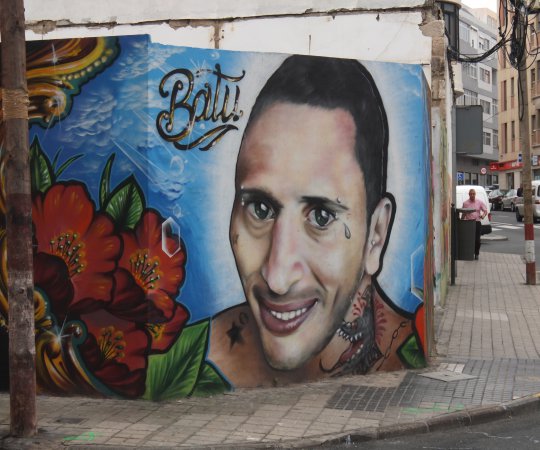Erasmus+ Journal (Issue 2) 2013/14
Matthias Klein, Spain, Universidad de Las Palmas de Gran Canaria, Mobility for Studies
Author: Matthias Klein
Overview, history
The Canary Islands are an archipelago off the coast of Morocco. Las Palmas de Gran Canaria is the Capital of the autonomic province of the Canary Islands and the largest city in the region.
When I came here I thought how much the island must have changed since the days of the conquest. Before the castilian crown gained the control over all 7 islands the people of the Guanches lived here. Experts are not sure where these people came from originally but most likely they where offspring of the "Berber" who live in the northern part of Africa. Till the year of 1873 the most important evidence of these people's life was not discovered. A farmer was about to extend his area of cultivable land for his bananas when whe fell into a hole and discoverded the so called "cueva pintada" a richly colored cave built by the aboriginal people. It should take another 100 years till archeological ecavation started and a whole village in the surrounding area of the cave could be released. This cave can be visited in Galdar in the north west of the island.
The island is rich of beautiful places an perfect for all who like roadbiking! It is a bit of a quest till you find a good way out of the city because in many cases you just end up on the highway (they love highways here) but once you found it you will be rewarded for your efforts. I would strongly recommend to buy a streetmap at home because you will not find a good one here.
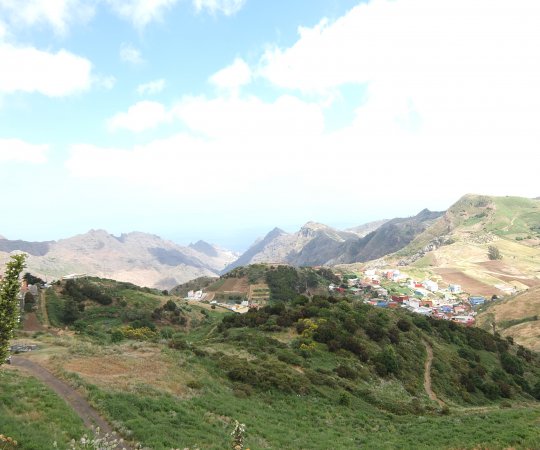
Picture 1: Cruz de Tejeda (Matthias Klein)
Comparison of education systems
Compaired to the education in Austria the Spanish way is a bit different. The faculty of the "formacion de profesorado" is the university for every becoming teacher. You finish your career with a bachelor degree and depending on your interests you are free to choose a masters degree. I was told that it would not be obligatory for elementry school but for all higher schoolforms.
Although the training in Austria is quite practical the spanish curriculum is even more practicly orientated. I completed a 8 weeks teacher training that is part of 3 big practical units within the curriculum.
To my mind the spanish system has the big advantage that you are free to choose a masters degree after the bachelor. You are not that limited to one thing like in Austria. If you complete the bachelor of education in Austria you are prepared to teach only one certain age group there is no permeability in the system.
Courses
I took part in several courses that I am going to describe in detail now.
1."Dificultades en el proceso de aprendizaje"-6 ECTS
Aims:
. identify learning difficulties and assist in their psychoeducational attention
. Identifying and planning on solving educational situations involving students with different abilities.
. Understand the historical development of special education.
. Analyze the institutional conditions and teaching practices that promote inclusion of pupils.
. Analyze and understand innovative experiences in the field of diversity.
. Designing measures of attention to diversity
Experience:
This course belongs to the module learning and personality pevelopment. It has to be absolvated in the second year and forms a fundamental subject in the teacher training to facilitate the detection of special needs, learning disabilities and social problems. The students, future teachers, meet and identify the various difficulties that may arise within a classroom. I was not satisfied at the begining of the course because we had to learn legal texts that where very difficult to understand because they where in Spanish. This went on for a couple of weeks but then we started to work out significant syptoms of differnt kinds of disabilities and derogation. During the last weeks of the class we worked with a quite useful index published by the Canarian educational department. This guidline mentioned various behaviour paterns that you could mark with applicable, quite applicable, not applicable. This does of course not count as a diagnosis but it may help you as a teacher to take the necessary steps.
2."Espanol como lengua extranjera"-6 ECTS
Aimes:
- Get to know the spanish cultre and the way of life.
- Learn about the local habits, usages and important details in the daily life
- Improve the linguistic skills form the level of A1 to A2 at the end of the course.
Experience:
This course was very useful for me because I had the chance to strengthen my skills that I gained during my course at home. In the first week the course instructors organized a grading test for all incomming Erasmus students in order to find the group you belong to. The groups where fragmented into the levels: A1/A2, B1, B2, C1, C2
The book that we used in the course was called "gente 1" and costed more or less 30 €. We where also told to buy the work book for about 20 € but we did not use it very often.
In addition to that we also used the online learning program "Duoling" that is to be found underthe following link: https://www.duolingo.com/
Duolingo is a very simple program that allows you to learn vocabulary and grammar very effectively on your own. I did the whole course and I would say that I gained the predominantly majority of my lexis thanks to that program.
3."Practicum II"-21 ECTS
Aims
- Gain safety in the roll as teacher
- widen the horizon of didactical possibility
- Gain an insight into the daily school operations
Experience:
I would call this part of my studies the most important one because it learned so much.
I started organizing my practicum when I was in Austria because I received a tip from a friend of mine who absolved this practicum last year at the same school. In hindsight I have to suggest everybody to take care of his/her things on /his/her own this applies to all areas of life on this island but especially if you need something very urgent.
In the first week there was alot of confusion about my practicum because although the learning agreement which contained the practicum II was transmitted out weeks before, no placement was provided for me. Nevertheless it worked out in the end so I was able to start my practicum.
Abigail Chavanel Cabrera, who is the very competent lady in the Erasmus office the "oficina de movilidad" helped me to clear up the misunderstanding.
The school where I did my internship was the colegio Heidelberg. (http://www.heidelbergschule.com/) It is a private school where the kids can start in the Kindergarden and stay till they are 18 years old. The school is considered quite good how ever the parents have to pay a lot of money for the school because in many cases they are not satisfied with the condition of public schools. You can read more about that topic under the headind "Vergleich der Ausbildungssysteme und des Studiums".
On the first day at school I came into the conference room and I thought: What is going on here? Why is everybody so friendly and cheerful? My first idea was that it is because we are in a private school with well-behaved children with good working conditions... That idea was wrong. A spanish teacher of the Eso. level (Educacion secundaria obligadoria) that is more or less the same as the Austrian Unterstufe has to be in class 24 every week. So far so good but these 24 hours the teacher has to teach his subjet, the one he studied for. Only in exceptional cases other subjects are taken. On the one hand that is good because it it guarantees that the teacher knows what he is talking about but on the other hand there is an enormous pressure for the teacher prepairing for example 24 clases of german every week. It my view the real reason is a drastic difference in the attitude to life. Here is laughed about problems and not cried like in Austria.
Now I am going to describe my obligations and the organizacion of my practical course.
My tutor during these 8 weeks was Hector Artiles a very likable and well-read man who has exactly my sense of humor. Therefore I came along very well with him and his class the 3 C. I spent most of the time in this class. For the first two weeks I was free to watch the tuition of the several teachers. Therefor Hector was so kind as to give me a little plan which I followed also for the rest of my stay.
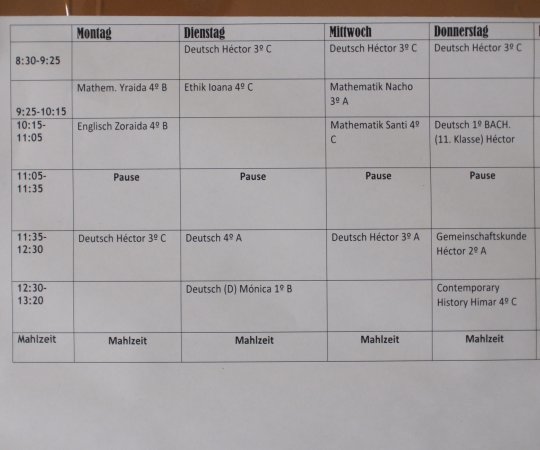
Picture 2: time table (Matthias Klein)
During the next 2 weeks I was like an assistant teacher. I helped the different teachers to correct homework and tests furthermore I was also given the chance to do small instruction sequences on my own. In mathematics the teachers let me even give entire clases! I loved that!
In the 3 C of Hector my task became to prepair and to hold a 3 week sequence about Anne Frank. The first week Hector stayed in the class but the following two I was on my own and it worked out great!! After the 3 weeks the kids had to prepair wallpapers that where marked by Hector. The kids where satisfied and a bit sad when it was over.
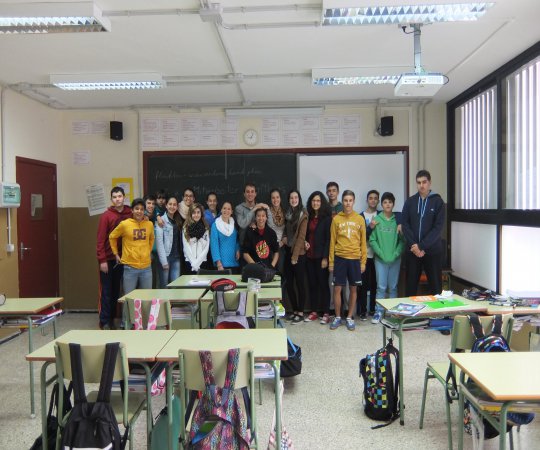
Picture 3: 3c Colegio Heidelberg (Matthias Klein)
Accreditation process
The process of application is quite simple. During the infomeeting that takes place in the first week of university you get told to appear in the "oficina de movilidad" in order to sign your matriculation. The matriculation is a piece of paper that contains your courses of the learning agreement and your user name for the online portal. Without a signed matriculation you are not allowed to take the exams.
But there is no need for stress because during the first mounth you are allowed to change your original courses if you want to. In that case speak with Abigail she will explain to you in detail what you need to do. However, I can tell you one thing, that it will cost a lot of patience.
The "oficina de movilidad" is to be found in the basement of the building of the linguists. And the building of the linguists is on the "campus de obelisco". The opening hours can be found in the pictrure below.
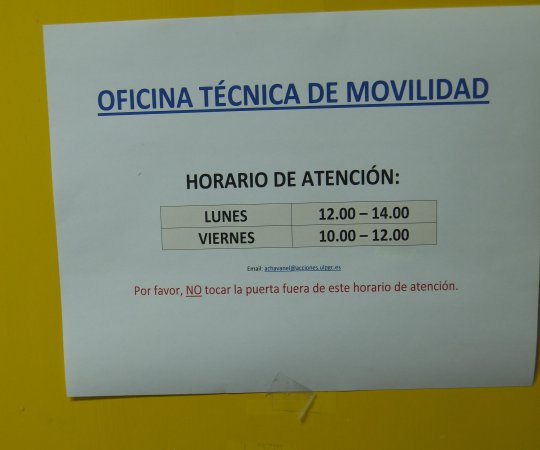
Picture 4: Oficina de movilidad (Matthias Klein)
Contact Information
Universidad de Las Palmas de Gran Canaria. ULPGC
Calle Juan de Quesada, nº 30 - Las Palmas de Gran Canaria - 35001 - España
http://www.ulpgc.es
Name of the Erasmus Corordinator: Abigail Chavenel Cabrera
achavanel@acciones.ulpgc.es
Accommodation
I found my shared flat very easy with the help of this facebook group: https://www.facebook.com/groups/accommodation.imp.ulpgc/. I lived together with two others in calle viriato nr. 40. The flat was very nice an big. In general you got to calculate between 200 and 250 € for a good flat. If you do not care there are also cheaper ones starting from 150 € per month. Electricity and water are not included.
When I came here I had to stay in a hostel for 2 weeks because my contract with the flat owner was not valid to that time. I would not recommend the lualua youth hostel. It is cheap but quite dirty. If I had the choice once more I would take the "ventana azul" http://www.grancanariasurf.es/de/unterkunft/. Some friends of mine lived there and they told me that it should be very nice.
Un poco sobre la vida
In general the life is a bit cheaper than at home. Due to the fact that the island was declarated as a free trade zone in 1852 the taxes are much lower compared to the main land. The special island value added tax is only 7%. Alcohol, cigarettes and petrol are also affected for instance one liter of petrol costs more or less one Euro.
The city is divided in three parts: the old town veguetta, the more or less modern las canteras and the "barrios" the districts on the outskirts of the city. I like the old tow very much especially on thursdays because there is allways a special offer that attracts the attention of many people. In the evening the bars sell drinks and tapas (little snacks) for very reasonable prices.
The district I lived in was las canteras. This part of the town is not very beautyful but therefor you can enjoy the very nice city beach and the night life with bars and clubs. For all those who like snorkeling I would strongly recommend to try out the area in front of the beach. Over a length of about 1.5 km a former reef builts a natural barrier for the big waves of the atlantic. A lot of fish use this protected zone so you can enjoy a big diversity right in front of the beach. If your discipline is more the scuba diving I would take this diveshop: www.7mares.es I would recommend to visit the spots "el cabron" and the wrecks next to Mogan in the south. At both sights there is a lot of life and cool things to discover. The sea is in a good condition and very clean because there is hardly any industry on the island that could pollute it.
The third part I want to describe are the barrios on the edges of the city where the less privelaged people live. Due to the great poverty and the lack of prospects the drug abuse and crime rate are high. Especially the very cheap and highly harmful methamphetamin enjoys strong popularity. One of the most famous residents of the barrio de alcaravaneras was "Batu the dog". Somehow he became quite famous in spain with his videos maybe because they illustrate the situation: https://www.youtube.com/watch?v=3fDu7Dy_L_I
